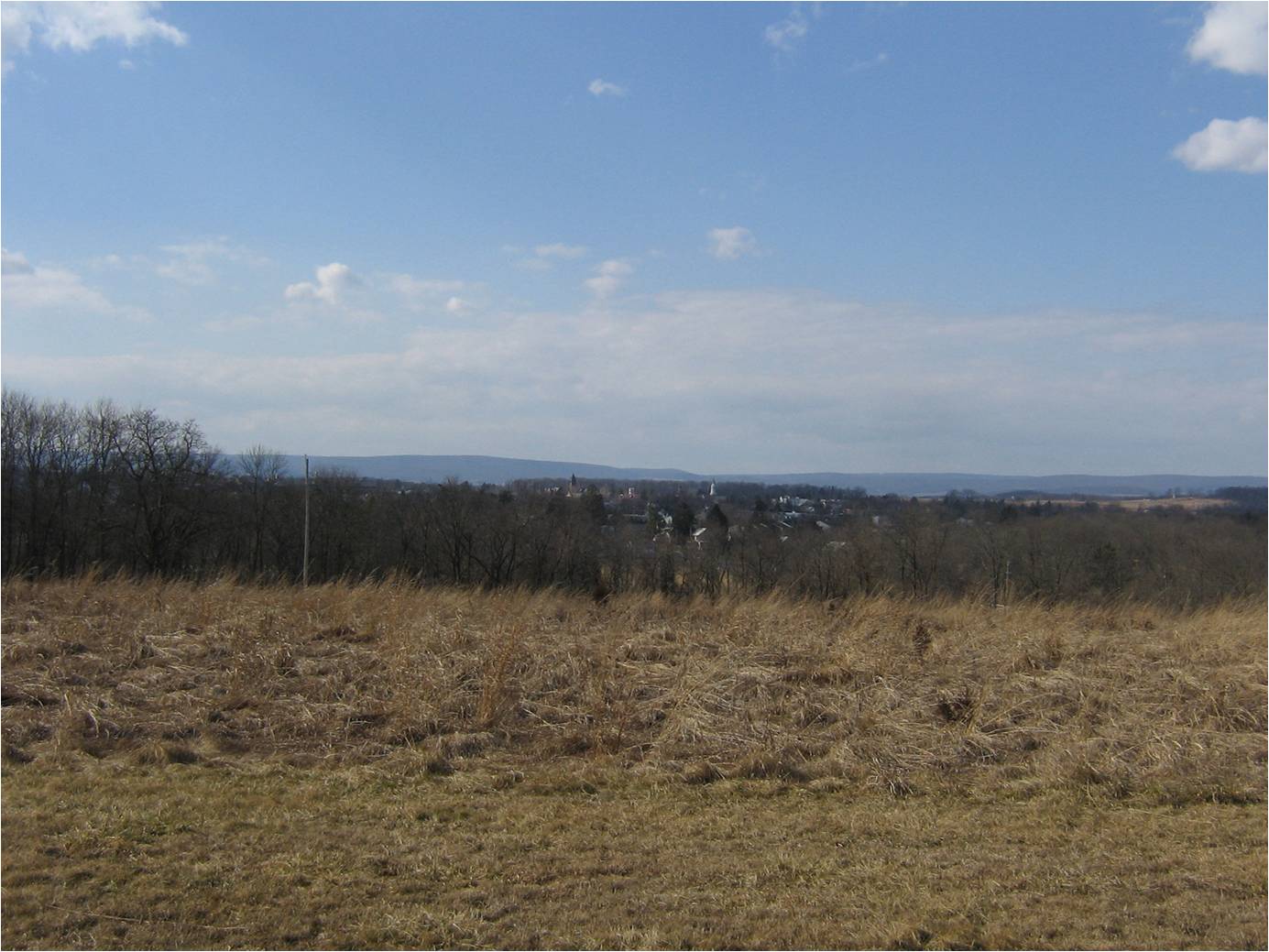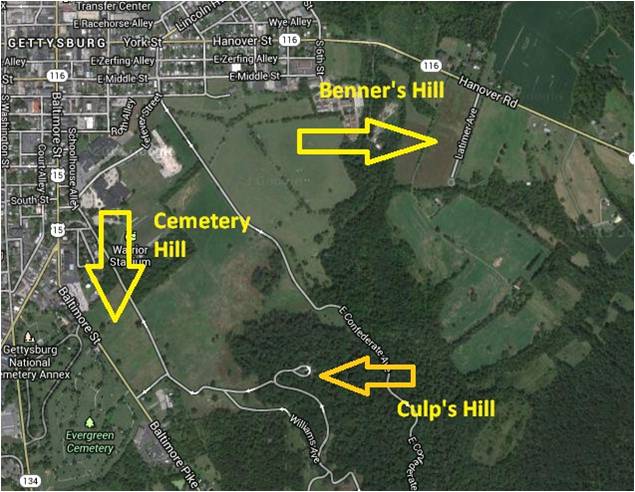Gettysburg Off the Beaten Path: Benner’s Hill

Just east of Gettysburg sits Benner’s Hill, a 574 foot high (458 feet according to the Bachelder map) prominence that overlooks the town of Gettysburg. At the base of this prominence runs Rock Creek, a barrier between the hill, town, and for the three days in July the two opposing armies. At the time of the battle, the hill was part of the 208 acre Christian and Susan Benner Farm. The Benner’s home sat about 400 yards south of the hill’s crest, closer to Wolf’s Hill.
Near 4:30 PM, on the afternoon of July 1st, Confederate cavalry in the form of the 35th Virginia Battalion of Cavalry rode east along the Hanover Road, which runs over the crest of the hill. Their commander, Lieutenant Colonel Elijah V. White, reported back to the Confederate high command of a body of Federal soldiers materializing east of Benner’s Hill. These Union troops also captured the attention of Brigadier General William “Extra Billy” Smith, commanding an all Virginia brigade in the area.
Confederate Second Corps commander Richard S. Ewell rode out to see what was happening. Indeed there were Union soldiers arriving out near Benner’s Hill, just about the time he received discretionary orders to take Cemetery Hill. (Click here to read a more detailed article on this action.) As quickly as the Union soldiers materialized, they disappeared. This distraction was enough to help stall Ewell’s attack on Cemetery Hill. One Union general called this action “…a timely diversion.”

On July 2nd Benner’s Hill was used as both an artillery platform and a staging area for the assault on Culp’s Hill. Five batteries, consisting of twenty guns stood atop the crest.* These guns were commanded by 19-year-old Maj. Joseph Latimer. Latimer was born on August 27, 1843, in Prince William County, Virginia. At the outbreak of the war, Latimer was a cadet at the Virginia Military Institute in Lexington, Virginia. He rose to command the Courtney Artillery, and by March of 1863 had risen to the rank of major. Second Corps staff officer Campbell Brown wrote of Latimer that he was “idolized by his own men and the infantry of his division as well. The latter called him the ‘Boy Major’ and sometimes cheered him as he passed-a distinction they conferred on very few.” Throughout the morning and early afternoon of July 2nd, Latimer rode along the Confederate left in search of and artillery platform that could engage the enemy lines on East Cemetery Hill and Culp’s Hill. Latimer settled on his only real option, Benner’s Hill.
Benner’s Hill sits astride the Hanover Road, which bisected the ridgeline. The crest ran some 300 yards south-southwest from the road, and nearly 500 yards north-northeast of the road. In 1863, the top of the crest was open, with wheat and corn patches dotting the top of the hill.

Lee’s offensive on July 2nd started on the Confederate left, as far away from Latimer’s guns as you could get on the battlefield. In the late afternoon of July 2nd Latimer’s guns came to life. They engaged 37 guns along the Federal right flank, from Culp’s Hill to East Cemetery Hill. Latimer’s gunners were easily outmatched in both quantity and quality of ordinance employed. Both Culp’s Hill and Cemetery Hill were more dominating positions than that of Benner’s Hill. The Federal guns engaging Latimer rained iron down upon his stout gunners.
Near dusk three brigades of Major General Edward “Allegheny” Johnson’s Second Corps division strode through Latimer’s gun line, which by now had been reduced to just four guns, toward Culp’s Hill. Latimer’s guns were quiet just long enough for Johnson’s men to make their way through. Latimer’s guns came back to life. More federal shells rained down. Latimer was hit in the left arm with a piece of shrapnel and his horse killed. Pinned below, Latimer was pulled free by a few of his men. Latimer’s arm was amputated, and he was evacuated with the army to Winchester. Latimer was then transferred to the home of Col. Edward T. H. Warren of the 10th Virginia Infantry in Harrisonburg, VA., where he died August 1, 1863 of gangrene, three weeks shy of his 20th birthday.
To reach Benner’s Hill, head east down York Street. At the Y intersection continue straight ahead, the road will turn into Hanover Street/Hanover Road (PA 116 East). As you ascend the hillside prepare to turn right at the top onto Latimer Ave (another one of those rare Confederate officer named park roads). This is Benner’s Hill. The total distance from the square to the hill is 1 mile.

Author’s Note: From Benner’s Hill the distance to Culp’s Hill (the hill with the large war department observation tower atop) is approximately 1,000 yards; the distance to Cemetery Hill approximately 1,500 yards.
If you follow the Hanover Road to the east you will arrive on Brinkerhoff’s Ridge where David Gregg’s Union cavalry division was engaging Johnson’s fourth brigade, the famed Stonewall Brigade. This action was enough to help tip the scales in favor of the Union on Culp’s Hill, during the July 2nd battle. One more Confederate brigade would have made all the difference in the world. For a more in-depth description of this action I highly recommend Protecting the Flank: The Battles for Brinkerhoff’s Ridge and East Cavalry Field, Battle of Gettysburg, July 2-3, 1863 by Eric Wittenberg. Brinkerhoff Ridge will be discussed in a later post.
*Latimer commanded sixteen guns in his battalion. Those were the guns of the Chesapeake (Maryland) Artillery (four 10-lb. Parrott Rifles), Alleghany (Virginia) Artillery (two 3-Inch Ordinance Rifles and two 12 Pounder Napoleons), 1st Maryland Battery (four 12 Pounder Napoleons), Lee (Virginia) Battery (two 20-lb. Parrott Rifles, one 10-lb. Parrott Rifle, one 3-Inch Ordinance Rifle). Latimer was also loaned the Rockbridge Artillery (four 20-lb. Parrott Rifles) from Capt. Willis Dance’s Second Corps artillery reserve battalion.
Have been researching my Great Grandfather(x3) who mustered into the 1st Rockbridge Artillery year before Gettysburg. I just this day have solved the mystery of where he fell injured, taken captive, and died three short months later at Point Lookout Military Prisoner or War Camp. Thanks so much for the article.
I am a descendant of Jacob Stock of 407 South Washington St. At the Battle of Getysburg, family lore says that the family vacated to Brenners Farm but I have an idea it is actually Beners farm, one of them. I was wondering if either of the Benner Farms held people escaping the fight? At the time of the battle I understand that Jacob Stock vacated to a house in town. Can you enlioghten me about the use of eithher farm house used as a refuge?
Latimer died in Harrisonburg, not Winchester.
Did you read what was written? “Latimer’s arm was amputated, and he was evacuated with the army to Winchester. Latimer was then transferred to the home of Col. Edward T. H. Warren of the 10th Virginia Infantry in Harrisonburg, VA., where he died August 1, 1863 of gangrene, three weeks shy of his 20th birthday” CLEARLY states he died in Harrisonburg.
Thanks, dad. Did YOU read the original post when it was written and before it was edited to reflect his actual death site? You clearly didn’t. Between your lack of civility and grasp of social media, I’ll be sure to discourage my guests from visiting your “museum.” Big kudos, champ.
Christian Benner is my 3x or 4x grand father and through research I have found that his home was occupied by the confederate army as a hospital
Wow???
Thanks for sharing your research, Christopher ????
All, pleez disregard the unwarranted ???s included with my prior reply. I didnt know this website was “anti-emojis” — My apologies
Years ago, I walked down Benner’s Hill and crossed Rock Creek, on a tour with Gary Gallagher and Pete Carmichael. A great tour!!
My great great grandfather Pvt John Boggs of Co H Wise Yankee catchers 50th Virginia volunteered to man a cannon on Benner’s Hill and was hit a glancing blow to the head by cannon ball. He was captured on the fourth and died August in Yankee field hospital. Would anyone have an idea where he is buried?
Richard, here’s a bit of info. May be worth reaching out to the SCV Camp mentioned: https://www.findagrave.com/memorial/37101033/john-r-boggs